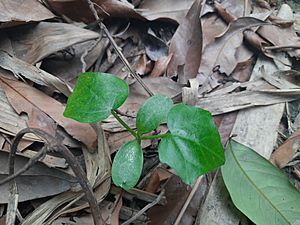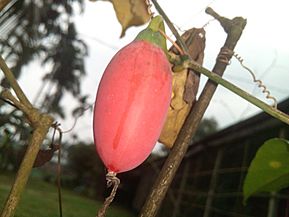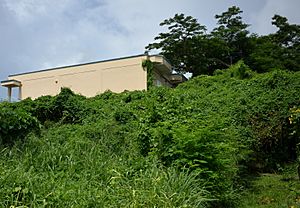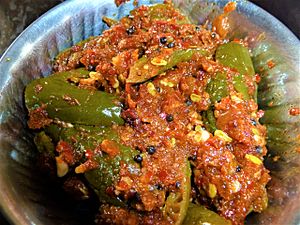Scarlet gourd facts for kids
Quick facts for kids Scarlet gourd |
|
|---|---|
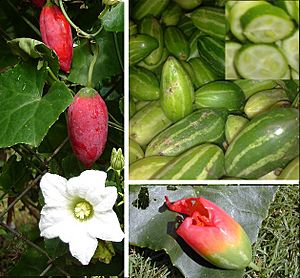 |
|
| Ivy gourd | |
 |
|
| Ivy gourd cross section | |
| Scientific classification | |
| Genus: |
Coccinia
|
| Species: |
grandis
|
Coccinia grandis, also known as the ivy gourd or scarlet gourd, is a tropical climbing plant. It is often called tindora or kowai fruit. This plant grows mainly in warm, tropical places, especially in India, where its fruits and young shoots are a common part of local meals. People cook Coccinia grandis as a vegetable.
Contents
What is Ivy Gourd?
Ivy gourd is a type of vine that grows quickly. It has single tendrils, which are like little arms that help it climb. Its leaves have five parts, like fingers, and are about 6.5–8.5 centimeters long and 7–8 centimeters wide.
This plant has separate male and female flowers. Both types of flowers grow where the leaves meet the stem.
Where Does Ivy Gourd Grow?
Ivy gourd naturally grows across Africa and Asia. This includes countries like India, the Philippines, China, Indonesia, Malaysia, Thailand, and Vietnam. It also grows in parts of Australia.
People have also brought ivy gourd to other places, such as Hawaii, Fiji, Guam, and Samoa. This often happens when people move plant pieces or seeds by accident. Birds, rats, and other animals can also help spread the seeds. In Hawaii, wild pigs might even help spread the fruit.
Ivy gourd can grow very fast, sometimes up to four inches a day! Because it grows so quickly and thickly, it can cover other plants. This blocks sunlight and takes away nutrients, which can harm the plants underneath. In places like Hawaii and Florida, ivy gourd is considered an invasive plant because it spreads so much.
Names in Other Languages
Ivy gourd has many different names around the world:
- In Hindi, it's called Kundru or Tendli.
- In Gujarati, it's Tindora.
- In Marathi, it's Tondli.
- In Tamil, it's Kovai.
- In Malayalam, it's Kovakka.
- In Telugu, it's Donda kaya.
- In Kannada, it's Tonde Kayi.
- In Bengali, it's Telakucha or Kundri.
- In Odia, it's Ban-kundri.
- In Assamese, it's Kunduli.
- In Sanskrit, it's Bimbika.
- In Mandarin, it's Hoong Gua.
- In Tulu, it's Manoli.
- In Maithli, it's Tilkor.
- In Sinhala, it's Kowakka.
- In Khmer, it's Sloekbaas.
- In Nepali, it's Barela.
- In the United States, it's sometimes called Rashmato.
Controlling Ivy Gourd Growth
Controlling ivy gourd can be tricky. Simply pulling the plant by hand often doesn't work because the vine can break into smaller pieces. These pieces can then grow into new plants if they touch the ground. One helpful way to control it is to pick the fruits and put them in plastic bags. This helps reduce the number of seeds in the soil.
Scientists have also tried using insects to control ivy gourd in Hawaii. Two types of weevils and a type of moth were released. The weevils' young (larvae) eat the plant, and the adult weevils chew holes in the leaves. This helps to damage the plant and slow its growth.
Traditional Uses and Health Benefits
In traditional medicine, different parts of the ivy gourd plant have been used for various purposes.
- The fruits were used to help with conditions like fever and asthma.
- The roots are used in Bangladesh to help with joint pain.
- A paste made from the leaves can be put on the skin to treat skin problems like scabies.
You can find ivy gourd extracts and products online or in health food stores. Some people believe these products can help control blood sugar levels. Research suggests that compounds in the plant might affect how the body handles sugar. Because of this, ivy gourd is sometimes suggested for people with diabetes. More research is being done to understand its potential as an antioxidant and for supporting the immune system. In some Asian countries, like Thailand, people make traditional tonic drinks from ivy gourd for health purposes.
Cooking with Ivy Gourd
Ivy gourd is best when cooked. Its taste is sometimes compared to bitter melon. It is a very popular vegetable in Indian cuisine. People in Indonesia and other Southeast Asian countries also eat the fruit and leaves.
In Thai cuisine, ivy gourd is used in popular clear soups like kaeng jued tum lueng and in curries such as kaeng khae and kaeng lieng.
In India, people cook ivy gourd in many ways:
- They deep-fry it with spices.
- They stuff it with masala (a mix of spices) and sauté it.
- They boil it first and then fry it.
- It's also used in sambar, which is a soup made with vegetables and lentils.
- Young, unripe fruits can be eaten raw in a quick pickle, keeping their crunchy texture.
Nutrition
Ivy gourd is a good source of beta-carotene, which is important for your body.
Images for kids


